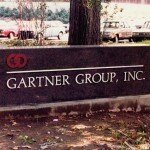 G.Gartner’s note: the purpose of this post is to describe Gartner Inc.’s own chronology of its early years, with my comments in brackets [ ], which represent an attempt to help set the record straight. This post is not meant to describe the innovations which resulted in Gartner’s growing from zero to dominating its field within a decade, the 1980s. I’ll switch my other posts about Gartner into this blog’s “IT Advisory Industry” category.
G.Gartner’s note: the purpose of this post is to describe Gartner Inc.’s own chronology of its early years, with my comments in brackets [ ], which represent an attempt to help set the record straight. This post is not meant to describe the innovations which resulted in Gartner’s growing from zero to dominating its field within a decade, the 1980s. I’ll switch my other posts about Gartner into this blog’s “IT Advisory Industry” category.
From a Gartner publication, presumably PR, around 1999-2000:
Gartner Group, Inc., was founded in 1979 by Gideon Gartner as a provider of research and analysis in the field of information technology (IT), with a specialization in information about IBM and its products. At the time that he created the company, Gartner already possessed many years of experience in the IT field, after having worked for IBM in both the United States and Europe in the company’s competitive intelligence operations division. Prior to that, he had received his bachelor’s degree in mechanical engineering at the Massachusetts Institute of Technology (MIT), and his masters of science degree in management at the Sloan School.
Following his stint at IBM, Gartner was a partner at Oppenheimer & Co., where he worked as an analyst and developed the research methods that later came to typify Gartner Group. While at Oppenheimer, Gartner was rated as the top individual securities analyst in the technology field for seven straight years by Institutional Investor. As computers became more prevalent in the work world, Gartner began to research and track the computer industry more so than did other securities dealers. He attended countless trade association meetings and IBM user meetings and combined that information with the knowledge he already possessed from his time at IBM to gain an insight into the industry that other analysts did not have. Thus, his research became quite valuable to those in the business of buying and selling computer and telecommunications equipment.
After Oppenheimer failed to pay as much attention to Gartner’s research as he wanted, Gartner decided to start his own company. At that point, other consulting firms like Dataquest had already established themselves as counsel for the Silicon Valley computer manufacturers, so Gartner decided instead to target his services at confused corporate computer users. He approached Oppenheimer with an opportunity for a partnership, but the company declined. Instead, Gartner teamed up with David Stein, and in 1979 the two launched Gartner Group, Inc., with only $675,000 in venture capital. Initially, they had no clients, but Oppenheimer soon agreed to give them existing contracts in exchange for royalties.
Gartner and Stein then went about the business of providing advice and information to buyers and sellers of computers. Their company spent a majority of its time tracking IBM and its advances, and then delivered information to clients in a substantially different form than did most other consulting firms. In attempting to help a client make a decision regarding a product or a marketing strategy, Gartner would forego the typical, lengthy, and often-ignored written study, opting instead for a straightforward and easy-to-understand one page memo. This strategy helped the company increase its customer base, and Gartner Group was soon a well-established presence on the IT scene.
The 1980s: Acquisitions and Adjustments
Gartner Group, Inc., soon became well known for its insider’s perspective on IBM and the comprehensive information that it possessed about the company’s products and services. In 1983, Gartner Group was actually sued by IBM, which alleged that the consulting company had illegally revealed IBM trade secrets. The suit was later settled out of court. Gartner was quoted in Intercorp as saying that IBM was known to consistently provide Gartner Group with “enough information so we don’t totally screw up, but not enough so that they are telling us what is really going on.” At that time, many of Gartner Group’s analysts were former employees of IBM, which may have led to the technology giant’s unease at having a third party counsel its customers about its products.
Meanwhile, Gartner had been developing an addition to the company that was engaged in providing the investment community with advice and information related to the IT industry. This new brokerage and investment division was separated from Gartner Group in 1985 and became a wholly owned subsidiary called Gartner Group Securities. The following year, after seven years of steady increases in sales and earnings since its foundation, Gartner Group initiated a public offering of its stock. Within a year, the company ranked ninth on Business Week’s 1987 list of “Best Small Companies and Corporations,” and an overwhelming majority of the top Fortune 100 companies were part of Gartner’s client list.
Just one year later, in 1988, the company was purchased for $90.3 million by the British communications firm Saatchi & Saatchi. No major changes were made within Gartner Group following the takeover, and business proceeded as usual for both entities, with Saatchi & Saatchi now acting as a holding company. Gartner Group benefited from the deal because its new owner was able to offer the still-growing company any necessary capital support, as well as help the consulting firm increase market share on an international level. Meanwhile, Saatchi & Saatchi would benefit from Gartner’s in-depth knowledge of the industry, in order to make wise decisions regarding future acquisitions.
By the time the acquisition by Saatchi & Saatchi was complete, Gartner Group had expanded from the one service it had offered when founded to 13 different “Continuous Services,” each of which provided in-depth analysis of different high-tech industry segments. Continuous Services were available for subscription to clients on an annual basis. Revenues for the 1988 fiscal year topped off at $40 million, which gave the company a profit of $2.3 million for the year.
Just a year later, however, Saatchi & Saatchi’s bid to become a business service powerhouse took a turn for the worse. After plowing through a short-lived and perhaps overzealous acquisition phase, the advertising and communications giant suddenly found itself short of cash and began making changes to avoid being taken over itself. In late 1989, it decided to begin selling off many of the consulting firms that it had just purchased, including Gartner Group. Gideon Gartner himself made plans to repurchase his company. [I could not see the company maintaining its position under the auspices of firms which knew nothing about our business. True, I was by then a Saatchi employee, but I converted my allegiance to Saatchi to my allegiance to all the employees, including of course myself]. In an attempt to disenchant any other potential suitors, Gartner stated that he would quit in 1991 when his contract expired if he lost the bidding, hoping that the idea of Gartner Group without its founder would be unappealing to another bidder.
The 1990s:
[Thus] In 1990, Gartner Group management led a leveraged buyout of the company, with assistance from Dun & Bradstreet and Bain the consulting firm, each of which shared ownership of Infiormation Partners, a Private Equity firm (Bain held 51% of the ownership). The new owner was listed as a group called Information Partners Capital Fund, L.P., while the company itself became Gartner Group, Inc. Holding Corp. (GHC). GHC was then merged back into Gartner Group, Inc., under new management, including a new president and CEO named Manny Fernandez. At that time, Gideon Gartner left the day-to-day operations of the company. [This Gartner Inc. write-up does not acknowledge that when Saatchi acquired Gartner and demanded that I sign a 5-year contract, I explicitly negotiated that I would leave afteronly approx. 2.5 years, on March 31, 1991, New management restructured the company, which had suffered losses during its time with Saatchi & Saatchi. [This write-up might have emphasized that Saatchi was forcing us to overstate planned revenues but to cut costs in order to show terrific financial forecasts and hasten a sale; in fact we refused to overstate our plan and resisted cutting costs; in fact, the morale of the firm declined dramatically under Saatchi's dictatorial attitude; I'm writing a book describing the buyback adventure which we won]. Although the company registered increased revenue figures during 1991 and 1992, its books remained in the red. Gideon Gartner stayed with the company–on paper only–until 1993, when he sold his equity position and completely severed ties with the company. [First of all, I voluntarily sold 90% of my new equity position on the moral grounds that were I to start a new firm, I should not have a significant share of a competitor. In fact, I stayed as Chairman until 3/31/93 and refused the board's offer to be connected to the firm as Chairman Emeritus, under the new regime (I did not respect their morals, for example firing people right and left among other actions to cut costs, and refused to bring on board two outside directors which they had promised to accomplish, in writing, but without our having legal enforcement rights. I actually then began to design a new model which I believed would be superior to Gartners', which ultimately became GiGa Information Group, the fastest Advisory growth ever, which unfortunately had its own governance issues during the weak economy of 2000/2001 and was sold to Forrester which was experiencing hard times as well, but was then invigorated]. In 1993, Gartner Group registered earnings of $6.8 million on $122.5 million in sales for the year. This boost in profitability enabled the company to go public again, listing and offering shares of its stock on the NASDAQ exchange. With offices spread throughout 20 different countries, Gartner Group continued to provide its growing client base with objective research and analysis of the IT industry. The company also began positioning itself for expansion, which it initiated with the acquisition of New Science at the end of 1993, and of Real Decisions from NYNEX Worldwide Services Group, Inc., in early 1994.
If 1994 was a successful year at Gartner, with earnings more than doubling to $15 million from sales of $169 million, then 1995 was stellar: earnings skyrocketed to $25.5 million from sales of $229.2 million. In July 1995, Gartner purchased a majority interest in Relational Courseware, Inc. (RCI), a developer of computer-based training products. RCI continued to operate as an independent company, although it now took advantage of Gartner’s worldwide distribution channels and could use Gartner’s extensive network of research analysts. Later that year, Gartner also expanded its holdings with the formation of Gartner Group Japan, K.K., and with the purchase of long-time IT consulting rival Dataquest. The Dataquest acquisition greatly increased Gartner’s share of the IT consulting market.
In 1996, Dun & Bradstreet’s (D&B) 54 percent stake in Gartner Group, Inc., was transferred to a D&B subsidiary called Cognizant Corp. The transfer of holdings, however, caused no major changes in Gartner’s day-to-day operations. The consulting company continued to seek out and purchase other companies that complemented its own services, including Internet vendor Fox Industries, Italian consulting entity Nomos Ricerca, J3 Learning (a leading provider of IT training products), and Mindware Technologies. In order to accommodate its rapid expansion efforts, the company increased its base of analysts by 25 percent. [The write-up ignores the fact that the acquisition binge which emphasized the new CEO's urge to diversify into the educational and related arenas, proved a disaster; most of the acquisitions were sold at a loss].
Gartner Group approached the end of the century in a position of dominance in the IT consulting industry. It was continually upgrading its product offerings and also expanding the mediums by which clients could access those services. For example, the late 1990s marked the surge in popularity and use of the Internet as a means of transferring and obtaining information, and Gartner took advantage of the trend by creating a website called @vantage. @vantage was a compilation of information about industry outlooks and research about the IT industry, in an easy-to-find and simple-to-use format.[In fact, Gartner was slower than virtually the entire industry in embracing the Internet].
Although Gartner Group had traditionally faced very few direct competitors in its field, the end of the century drew rumors that Gideon Gartner was planning on launching his own IT consulting service. Even in the face of competition by its own founder, however, Gartner Group still possessed major advantages: years of experience and a stellar reputation among a client base that included almost all of the top companies in the world.”
There is no question that Gartner had already become #1 by a large margin, but its growth was temporarily dampened by my competition via Giga Information. In fact, Giga grew much faster than early Gartner, reaching revenues of just under $70M within 4 years of its first customer shipment (!) with no acquisitions (except one which was acquired prior to our first company ship, which was however disbanded within three years); Gartner itself had not reached $70 million until its tenth year; Giga simply proved that Gartner was vulnerable to improved models, which is still the case.







53 Comments